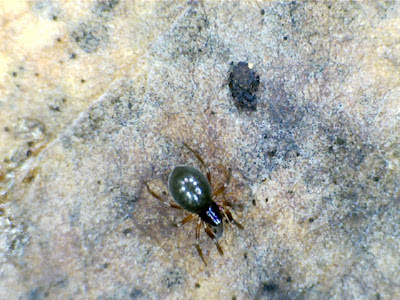Springtails are important part of soil ecosystems and feed on decomposing plants and animals, excrement, fungi, algae, and bacteria, others are predators of smaller animals. They are predated by many organisms, including small birds, spiders, harvestmen, centipedes
There are over 250 sp of British springtails, and at first, that seems a bit discouraging as to trying to identify them. In addition, they can be minuscule! The largest UK springtails are around 6 mm, and the smallest are 0.2 mm, close to the limit of what is visible with the naked eye (especially if you are starting to be a little long sighted!). On the positive side, some of the common species are quite distinctive and with a little practice, identifying others to genus can be done, with a little help of macrophotography.
Lepidocyrtus cyaneus, an iridescent blue springtail
Tomocerus minor, another iridescent springtail.
I was trying to take some photos of one of these lovely Hypogastrura purpurescens. They look rubbery and matt, in contrast to the iridescent species...
...when this tiny spider jumped onto the field of vision and ate one of them - just visible at the front of the spider. I wished I had taken a video of that!
Despite its name, this is one of the large springtail species, Tomocerus minor, here posing with a woodlouse
A relative of the Lion Springtail, the handsome Orchesella cincta
I like to call this species the Lion springtail, as it's got a wonderful mane (also top photo). Orchesella villosa. I often find in on fallen apples (top).
Cyphoderus albinus, a springtail often found in ant nests.
Protaphorura sp. a large aggregation on a rotting plant. This is actually a springless springtail, as it does not have a furca. Also, as the previous one, it has no eyes or pigment, as they often live underground.
Entomobrya intermedia
Now I see springtails everywhere. Click to see the full resolution photo and you will notice that there are many springtails - and some bark lice - around these overwintering Harlequins.
More information
A photographic key to common UK springtails.
Collembola of Britain and Ireland. Steve Hopkin's site with distribution maps.
Checklist of the Collembola. With lots of info on springtail biology.














1 comment:
Interesting article. I'm very much into photographing springtails, an occupation most of my friends find "quaint". I think they are fascinating and getting down into their world opens up whole new landscapes populated by challenging, beautiful and at times downright scary creatures. There is a whole ecosystem within a few square inches of my garden, park or woodland.
Julian Smart
jswildlife on Flickr
@jswildlife on twitter
Post a Comment